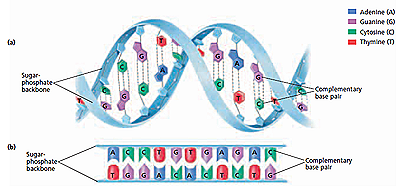In the 1950s, a young American biologist, James Watson, teamed up with British graduate student Francis Crick at Cambridge University in England to try to determine the structure of DNA. By 1953, they had put together a model for the structure of DNA as shown in Figure 10-4. They proposed that DNA is made of two chains that wrap around each other in the shape of a double helix, a shape similar to a winding spiral staircase. Their final model was correct and was remarkable because it explained how DNA could replicate.
Watson and Crick relied on other scientists’ work to develop their DNA model.Part of that work was X-ray diffraction photographs of DNA crystals. The photographs and crystals were produced by researchers Rosalind Franklin and Maurice Wilkins, at King’s College in London.
In 1962, Watson, Crick, and Wilkins received the Nobel Prize in Medicine for their work on DNA. Rosalind Franklin died in 1958 and so could not be named in the award. However, an important genetics institute in Cambridge now bears her name, and her contribution is recognized around the world.
DNA NUCLEOTIDES
DNA is a nucleic acid made of two long chains (also called strands) of repeating subunits called nucleotides. Each nucleotide consists of three parts: a five-carbon sugar, a phosphate group, and a nitrogenous base. The five-carbon sugar in a DNA nucleotide is called deoxyribose. The phosphate group consists of a phosphorus (P) atom bonded to four oxygen (O) atoms. The nitrogenous base contains nitrogen (N) atoms and carbon (C) atoms and is a base (accepts hydrogen ions).
The DNA double helix is similar to a spiral staircase. The alternating sugar and phosphate molecules form the side “handrails” of the staircase. Nucleotides along each strand are connected by covalent bonds between the sugar of one nucleotide and the phosphate group of the next nucleotide. Each full turn of the DNA helix has 10 nucleotide pairs.
The nitrogenous bases (called “bases” for short) face toward the center of the DNA molecule. The bases on one strand of DNA face—and form bonds called hydrogen bonds with—the bases on the other strand. Nitrogenous bases are bonded in pairs between the two strands by two or three hydrogen bonds. The base pairs form the “steps” of the staircase. The base pairs are of uniform width because, in each pair one base has a two-ring structure and the other base has a single-ring structure.
Hydrogen bonds between the bases help hold the two chains of the DNA double helix together, as shown the figuer below.
Nitrogenous Bases
The sugar and phosphate group are identical in all DNA nucleotides. However, the nitrogenous base may be any one of four different kinds—thymine, cytosine, adenine, or guanine . The nitrogenous bases and their chemical structures, called rings. The nitrogenous bases are often represented by the first letter of their name—T (thymine), C (cytosine), A (adenine), and G (guanine).Nitrogenous bases that have a double ring of carbon and nitrogen atoms, such as adenine and guanine, are called purines. Nitrogenous bases that have a single ring of carbon and nitrogen atoms, such as cytosine and thymine, are called pyrimidines.
Complementary Bases
In 1949, American biochemist Erwin Chargaff observed that the percentage of adenine equals the percentage of thymine, and the percentage of cytosine equals that of guanine in the DNA of a variety of organisms. This observation was key to understanding the structure of DNA because it meant bases pair by base-pairing rules—in DNA, cytosine on one strand pairs with guanine on the opposite strand, and adenine pairs with thymine. These pairs of bases are called complementary base pairs. Notice that each complementary base pair contains one double-ringed purine and one single-ringed pyrimidine.
Because of the base-pairing rules, the order of the nitrogenous bases on the nucleotides in one chain of the DNA molecule is complementary to the order of bases on the opposite chain. For example, if a DNA chain has the sequence ATTC, then the other chain must have the complementary sequence TAAG. The order of nitrogenous bases on a chain of DNA is called its base sequence.Complementary base pairing is important in DNA structure and function for two reasons. First, the hydrogen bonds between the base pairs help hold the two strands of a DNA molecule together. Second, the complementary nature of DNA helps explain how DNA replicates before a cell divides. One strand of a DNA molecule can serve as a template for making a new complementary strand.
DNA Models
The structure of DNA is often simplified when it is drawn or modeled. For example, the DNA double helix is often illustrated as a straight ladder. The ugarphosphate “handrails” are drawn as a straight line so that the basepair “steps” between the DNA strands are easier to see. Notice that simplifying the DNA structure highlights the complementary base pairs in each of the DNA nucleotides. In some cases the structure of DNA is simplified even more by just writing the first letter of each of the nitrogenous bases in the DNA nucleotides.For example, the DNA in figure above would be represented by:











0 comments :
Post a Comment